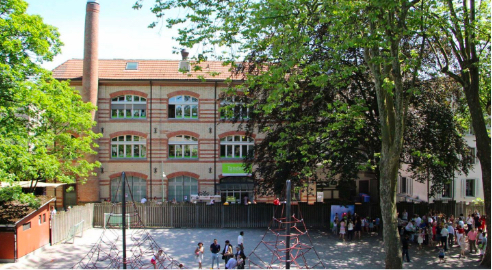The introduction of Emergency Alert Systems in Swiss schools has been slowly but surely revolutionising the safety and welfare of both students and faculty. In this picturesque nation, celebrated for its precision and unwavering attention to detail, technology has been embraced to establish an environment that prioritises security for future generations.
Switzerland is actually one of the safest countries to both visit and reside in, ranking consistently well in the annual Global Peace Index – coming in 10th for the most peaceful, safest place on earth in 2023.
One of the reasons experts suggest for the general sense of enhanced peace and safety in Switzerland is that Swiss people are typically well educated. According to a study by the Organisation for Economic Cooperation and Development (OECD), a massive 86% of Swiss adults have obtained a high school diploma; the higher the level of education, the fewer cases of criminal activity we tend to see. Still, no country is without its security concerns, and naturally, safety at schools should be of primary importance.
Here, we’ll delve into the multitude of benefits that Emergency Alert Systems (EAS) are bestowing upon Swiss educational institutions.
Accelerated Response Times
Swiss schools equipped with EAS have witnessed a substantial decrease in response times during emergencies; these systems enable immediate notifications to first responders, school authorities, and parents when crises arise. For example, in the face of natural disasters like avalanches or seismic events – of which Switzerland is prone to experiencing – these systems provide instantaneous alerts that facilitate swift evacuations and responses, ultimately minimising potential harm.
Enhanced Communication Channels
A school emergency notification system offers up an array of communication channels, such as text messages (which can be used for brief notices or to send an SMS link leading to more information), emails, and automated phone calls – this multi-faceted approach ensures that information is disseminated swiftly and reaches every member of the school community. In Swiss schools, where many families originate from diverse linguistic backgrounds, the ability to communicate in multiple languages proves advantageous, ensuring critical information is comprehended by all.
Customisation and Adaptability
Swiss educational institutions have reaped the rewards of EAS customisation features, tailoring these systems according to each school’s specific needs. For example, schools situated in mountainous regions may have distinct requirements when compared to those located in urban areas; the systems can be programmed to address specific threats, such as landslides or urban security concerns, rendering the alert system highly relevant and efficient.
Regular Drills and Preparedness
 The implementation of EAS in Swiss schools has facilitated regular safety drills that heighten preparedness among students and staff members for emergency situations. Through these drills, combined with the utilisation of technology, everyone becomes well-versed in emergency protocols and can respond appropriately. This state of preparedness significantly diminishes panic and chaos during actual emergencies, allowing for more orderly and efficient evacuation and response procedures.
The implementation of EAS in Swiss schools has facilitated regular safety drills that heighten preparedness among students and staff members for emergency situations. Through these drills, combined with the utilisation of technology, everyone becomes well-versed in emergency protocols and can respond appropriately. This state of preparedness significantly diminishes panic and chaos during actual emergencies, allowing for more orderly and efficient evacuation and response procedures.
Assurance for Parents
For parents, the introduction of Emergency Alert Systems in Swiss schools has brought about immeasurable relief; the knowledge that the school possesses a robust mechanism to handle emergencies and that they will be promptly informed in case of any incidents provides an invaluable sense of security.
Integration with Local Emergency Services
One of the standout advantages of EAS in Swiss educational institutions lies in its seamless integration with local emergency services. This synchronisation enables schools and emergency personnel to collaborate seamlessly during crises, ensuring a coordinated and effective response; a collaboration that has played a pivotal role in efficiently managing emergencies, ultimately saving lives and reducing injuries.
Cost-Effectiveness and Efficiency
While the initial setup cost of an Emergency Alert System may require some investment, Swiss schools have discovered that these systems prove cost-effective in the long run. The efficiency and rapid responses to emergencies have resulted in reduced expenses associated with property damage and healthcare, underscoring the wise and prudent decision to invest in EAS.
Challenges and What’s Next
There is no doubt that Emergency Alert Systems or EAS in Swiss schools are beneficial, but they don’t come without their fair share of challenges. To install and maintain such systems can be financially hard, filled with technical hurdles, and hard to make user-friendly to all age groups. Schools are doing their best to find solutions around these barriers while still keeping up with technology advancements like e-learning and online tutoring, all while staying one step ahead of any cybersecurity threats.
The Fear of Cybersecurity and Data Issues
When it comes to handling sensitive information, EAS must be protected against cyber threats. Swiss schools are working closely with experts in cybersecurity to implement strong protocols, helping to ensure privacy for both staff and students alike. Additional audits and system updates will also occur periodically to prevent unauthorised access.
Enhancing Technology For The Future
Emergency Alert Systems in Swiss schools may very well see the day of using more advanced technologies in the future. Take Artificial Intelligence (AI), Machine Learning (ML) and online tutoring for instance; these technologies could be used together to predict potential emergencies before they happen, along with automating responses when one occurs. The Internet of Things (IoT), which refers to any device connected to the internet, could also be implemented into the EAS for real-time monitoring during emergencies.
Expanding the Scope of EAS
Strategists over at Swiss schools are brainstorming ways on how they can expand what their Emergency Alert Systems are capable of beyond immediate crises; this includes using them for daily communications within a school facility, health alerts and even integrating educational tools that can be used during lockdown situations or instances where remote learning is required.
In Closing
The Swiss education system knows that there are challenges in place when it comes to improving their Emergency Alert Systems; still, they are not ignorant to that fact, and are actively addressing them while also exploring future opportunities for enhancement. This commitment will ensure that these systems remain an integral part of the education landscape in Switzerland, offering not just peace of mind to students and staff, but parents as well.


